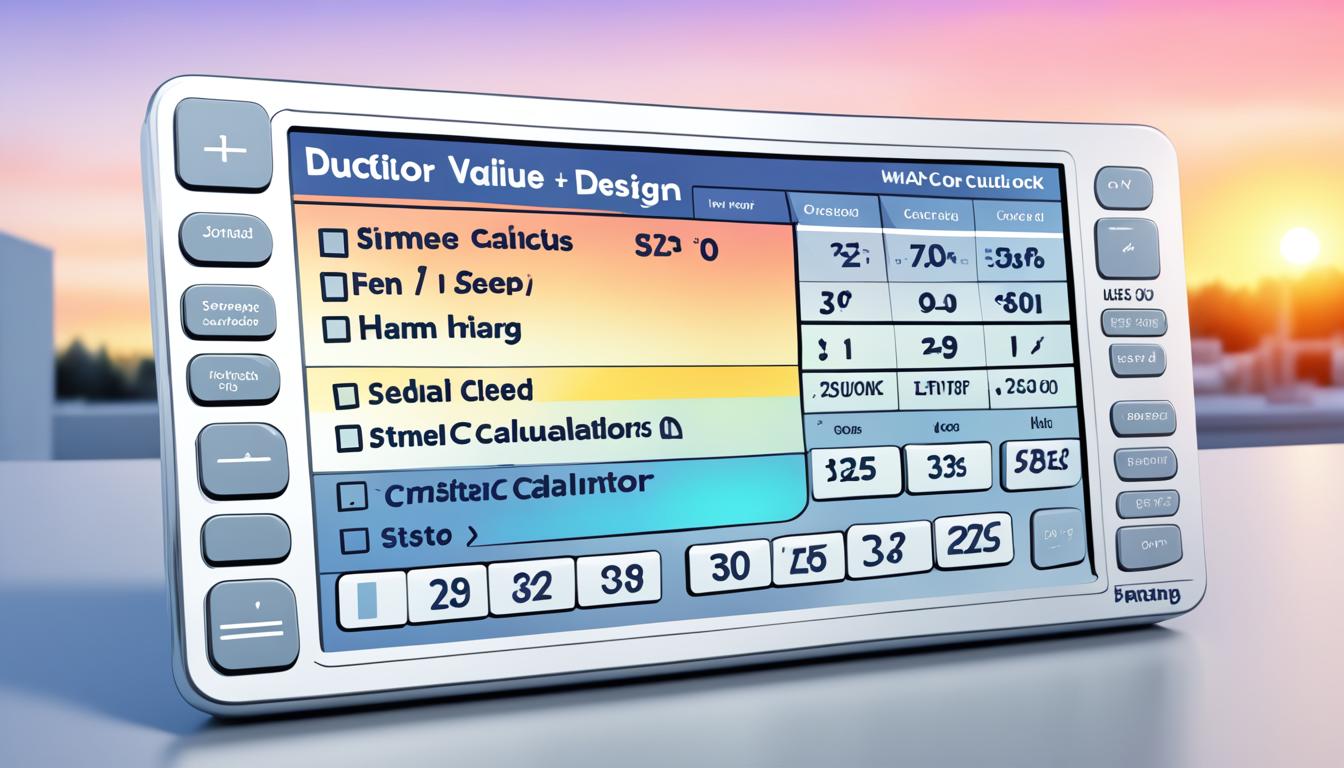You can use free HVAC load calculations to size your ductwork right. These calculations are key for an energy-efficient HVAC design. They help ensure proper airflow and system performance. With online ductwork sizing calculators, you can find the right dimensions. This depends on room size, air velocity, and static pressure.
Getting ductwork sizing right is key for your HVAC system’s life and efficiency. If ducts are the wrong size, it can wear out components faster. It can also increase energy bills and make air distribution poor in your space. Free online HVAC load calculation tools give you accurate sizing advice to avoid these problems.
Learning to use these tools lets you design an HVAC system that works best. This knowledge helps you make your indoor space comfortable. It also cuts down on energy use and maintenance costs.
Understanding the Importance of Proper Ductwork Sizing
Proper ductwork sizing is key to your HVAC system’s performance. It ensures better airflow, comfort, and energy savings. Let’s see why duct sizing is important and its impact on your home’s climate control.
Impact on HVAC System Efficiency
Proper duct sizing is crucial for HVAC efficiency. If ducts are too small, your system works too hard, reducing efficiency. On the other hand, oversized ducts cause air to move too slowly, leading to temperature issues. Correct sizing means optimal airflow, boosting your system’s performance.
Consequences of Incorrect Duct Sizing
Incorrect duct sizes can lead to high costs and discomfort. You might face:
- Uneven heating and cooling
- Higher energy bills
- Sooner system wear and tear
- Poor indoor air quality
- More noise from the HVAC system
Energy Savings and Comfort Benefits
Choosing the right duct size brings big energy savings and comfort. You’ll get:
| Benefit | Description |
|---|---|
| Lower energy bills | Less energy use due to reduced system strain |
| Consistent temperatures | Even airflow across your home |
| Improved air quality | Less dust and allergens from proper airflow |
| Extended system lifespan | Less wear on HVAC parts |
| Quieter operation | Less noise from air moving through ducts |
By making sure your ductwork fits right, you’re making your home’s climate control better, more efficient, and cost-effective.
Fundamentals of HVAC Load Calculations
HVAC load calculations are key to efficient heating and cooling. They help pick the right equipment for your home. This ensures you stay comfortable and save on energy.
Manual J Calculations Explained
Manual J calculations are approved by the ACCA for HVAC sizing. They look at many factors to find out what your home needs for heating and cooling. Your home’s size, insulation, windows, and local weather are all considered. This gives you accurate HVAC load factors.
Factors Influencing HVAC Load
Many things affect your HVAC load:
- Your home’s square footage
- The climate zone
- How well your insulation is
- The types and sizes of your windows
- How much air leaks out
- The number of people living there
Each of these factors is important for figuring out your HVAC needs.
Importance of Room-by-Room Analysis
Looking at each room separately is crucial for sizing your HVAC right. This way, every area gets the right amount of heat or cool air. A detailed look at each room helps prevent hot or cold spots. It makes your home more comfortable.
Knowing these basics helps you make smart choices about your HVAC. You’ll pick the right equipment, which means better energy use and comfort at home.
Use Free HVAC Load Calculations for Optimal Ductwork Sizing
Free HVAC load calculations are key for the right ductwork size. They help figure out the best duct sizes for heating and cooling. With free HVAC design tools, your system works better and saves energy.
To use free HVAC load calculation software, you need to enter some details. These include room sizes, climate info, and building features. The software uses this info to give you precise ductwork sizing.
Here’s what affects HVAC load calculations:
| Factor | Impact on Ductwork Sizing |
|---|---|
| Room Size | Larger rooms need bigger ducts |
| Insulation | Good insulation lets you use smaller ducts |
| Windows | More windows mean more heating and cooling needed |
| Climate | Harsh climates need bigger ducts |
Free HVAC load calculations help you dodge common ductwork mistakes. Big ducts waste energy, and small ones overwork your system. The right size means better comfort, lower bills, and longer equipment life.
Getting your data right is key for good results. Make sure to measure carefully and know your building well. This way, the free HVAC design tools give you the best ductwork advice.
Step-by-Step Guide to Calculating Square Footage
Getting the square footage right is key for your HVAC system and ductwork. This guide will show you how to measure your space well. This ensures your system works its best.
Measuring Regular and Irregular Spaces
For rooms with straight lines, figuring out the square footage is easy. Just multiply the length by the width. For instance, a 15 by 12 foot room is 180 square feet.
But, measuring irregular shapes is trickier. Break them down into simpler areas. Add up the square footage of each part for the total.
Utilizing Building Blueprints and Real Estate Listings
Building blueprints give you exact square footage. They show detailed floor plans, helping you count every inch. Real estate listings also list square footage, which can help kick off your calculations.
| Method | Pros | Cons |
|---|---|---|
| Manual Measurement | Accurate, accounts for recent changes | Time-consuming, potential for human error |
| Building Blueprints | Precise, includes all spaces | May not reflect recent renovations |
| Real Estate Listings | Quick reference, easily accessible | May be outdated or rounded estimates |
Getting the square footage right is vital for picking the right HVAC system and ductwork. Take your time to measure well. Use the best method for your space.
Determining Air Duct Sizing by Velocity of Air
Air velocity is key to sizing ducts correctly. It’s important to know how air moves in your system for the best HVAC performance. The main measure is cubic feet per minute (CFM).
CFM is crucial for sizing ducts right. First, figure out the CFM each room needs using Manual J load calculations. A good starting point is 400 CFM per ton of HVAC capacity.
For precise airflow sizing, consider these factors:
- Room size and function
- Sun exposure
- Insulation levels
- Number of windows and doors
Usually, 1 CFM can heat or cool 1 to 1.25 square feet. Rooms getting a lot of sun might need up to 2 CFM per square foot. Getting CFM right helps avoid hot or cold spots in your home.
| Room Type | CFM per Square Foot |
|---|---|
| Standard Room | 1 – 1.25 CFM |
| Sun-Exposed Room | Up to 2 CFM |
Mastering air velocity and CFM calculation leads to the right duct sizing. This makes your HVAC system work better, saving energy and keeping your home comfortable.
Calculating Required HVAC Unit Size
Finding the right HVAC unit size is key for good performance and saving energy. It involves changing BTUs to tonnage and figuring out airflow. Let’s look into these steps to make sure your system fits your needs for cooling and heating.
Converting BTUs to Tonnage
To pick the right HVAC unit, you need to switch BTUs to tonnage. One ton of cooling is equal to 12,000 BTUs. Just divide your total BTU load by 12,000 to see how many tons you need. For instance, if your home needs 36,000 BTUs, you’ll want a 3-ton unit. Always go up a bit for fractions to make sure it’s enough.

Estimating Airflow in Cubic Feet per Minute (CFM)
Once you know the tonnage, figuring out airflow is next. Just multiply the tonnage by 400 CFM, which is what most tons produce. So, a 3-ton unit needs about 1,200 CFM of airflow. This makes sure your system can do well with both heating and cooling.
| HVAC Unit Size (Tons) | BTU Capacity | Estimated CFM |
|---|---|---|
| 1.5 | 18,000 | 600 |
| 2 | 24,000 | 800 |
| 2.5 | 30,000 | 1,000 |
| 3 | 36,000 | 1,200 |
| 3.5 | 42,000 | 1,400 |
Knowing how to size HVAC units helps you make smart choices. The right size means comfort, saving energy, and your system lasts longer.
Mastering the Duct CFM Calculation Formula
Learning how to calculate duct CFM is key for your HVAC system to work well. This method helps figure out how much airflow each room needs. This ensures air flows evenly across your home.
Room-Specific CFM Requirements
To find out how much airflow each room needs, use this simple formula:
Room CFM = (Room load / Whole house load) × Equipment CFM
This formula looks at each room’s unique cooling or heating needs compared to the whole house. By knowing the CFM for each room, you can make sure every area gets the right amount of air.
Whole House vs. Individual Room Calculations
Calculating the whole house HVAC load gives you a broad view. But, calculating room by room gives you detailed insights. Here’s how they compare:
| Aspect | Whole House Calculation | Room-by-Room Calculation |
|---|---|---|
| Accuracy | General estimate | Precise for each space |
| Comfort Level | May have uneven temperatures | Balanced comfort throughout |
| Energy Efficiency | Potentially less efficient | Optimized for each room |
| Ductwork Design | Basic layout | Tailored to specific needs |
Mastering duct CFM calculation and looking at both whole-house and room-by-room needs helps you get the best airflow. This way, your HVAC system works more efficiently.
Understanding Friction Loss Rate in Ductwork Design
Friction loss rate is key in designing duct systems. It helps decide on duct sizes and shapes. You must know about available static pressure and total effective length to understand this.
Calculating Available Static Pressure (ASP)
Available static pressure is crucial for good airflow. First, find the Total External Static Pressure (TESP). Then, subtract pressure drops from components like filters and coils. This gives you the ASP for your duct design.

Determining Total Effective Length (TEL)
Total effective length is the sum of the longest duct run and equivalent lengths for fittings. Measure the longest straight duct path. Add lengths for elbows, transitions, and other fittings. This total is your TEL.
With ASP and TEL, you can figure out friction loss rate using this formula:
Friction Rate = (ASP × 100) ÷ TEL
Higher friction rates mean you can use smaller, more restrictive ducts. Lower rates need bigger ducts for smooth airflow. Finding the right balance is crucial for a good duct system design.
Knowing about friction loss rate helps make efficient HVAC systems. It ensures good airflow and comfort in your space. Remember these points when planning your ductwork for the best outcome.
Exploring Different Duct Materials and Their Impact
The choice of duct material is key for HVAC systems. It affects how well the system works. By comparing different duct materials, you can pick the best one for your space.
Sheet metal ducts are strong and let air move easily. They’re a top pick for many HVAC setups. Flexible ducts, however, fit well in small spaces but might not move as much air as sheet metal.
Duct board is a mix between sheet metal and flexible ducts. It’s made of coated fiberglass and insulates well while keeping airflow good. Remember to consider its properties when using duct sizing calculators.
How you install flexible ducts changes how well they work. If installed right, they work great. But, sharp turns or twists can reduce their performance. Plan your HVAC system carefully to get the best airflow and efficiency.





0 Comments